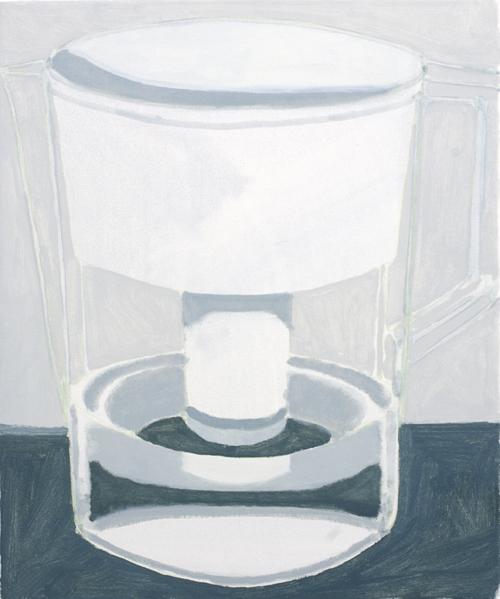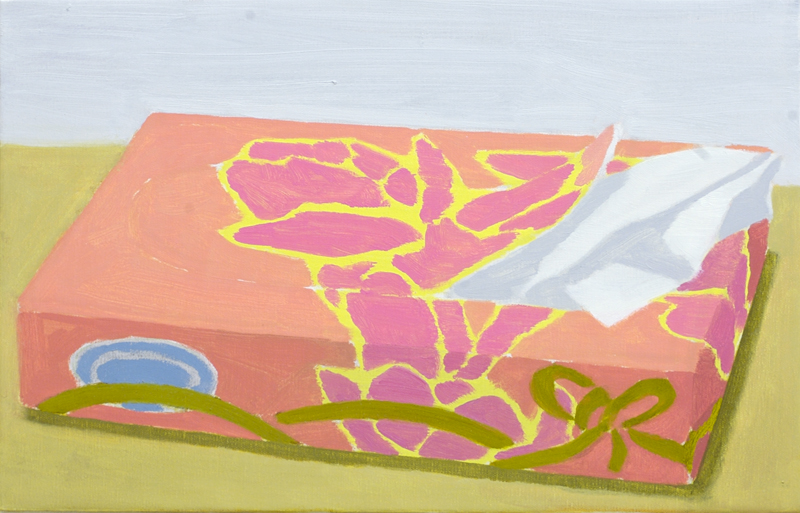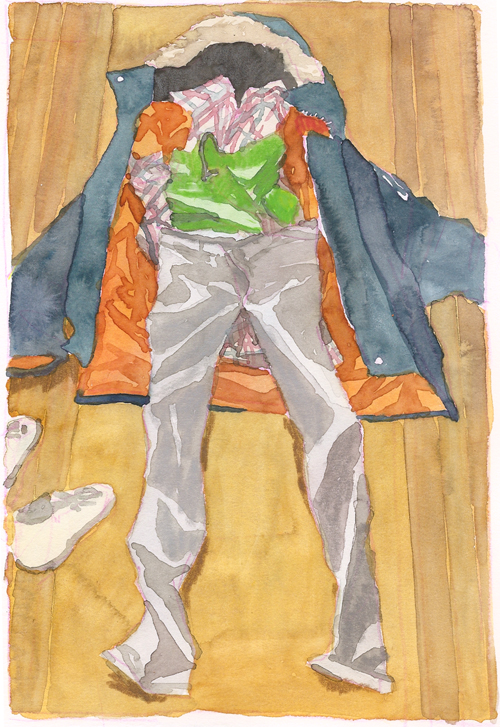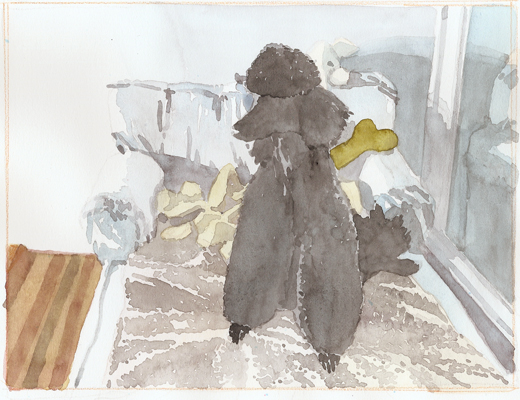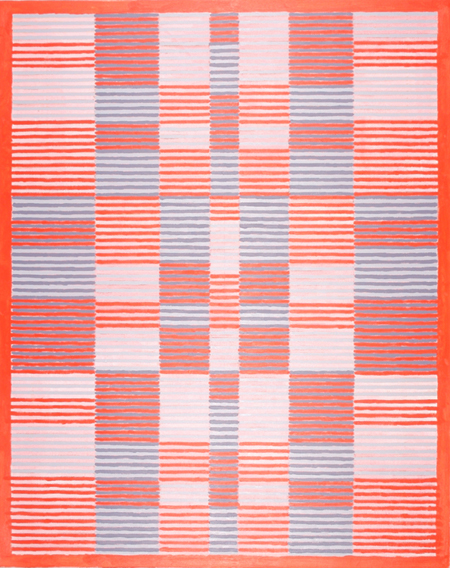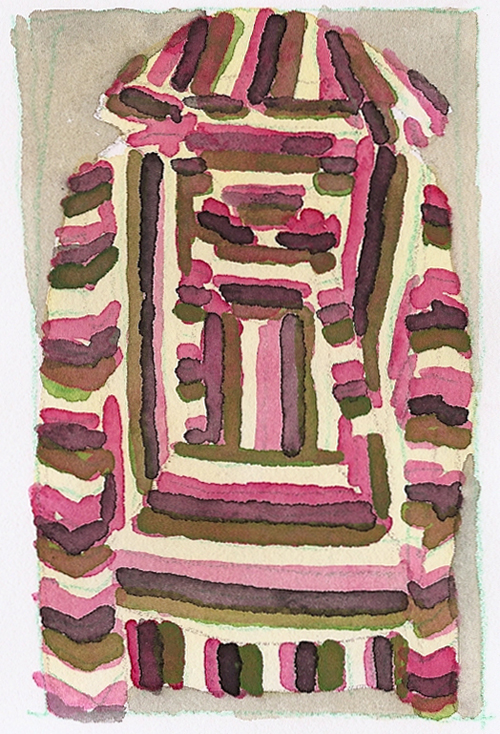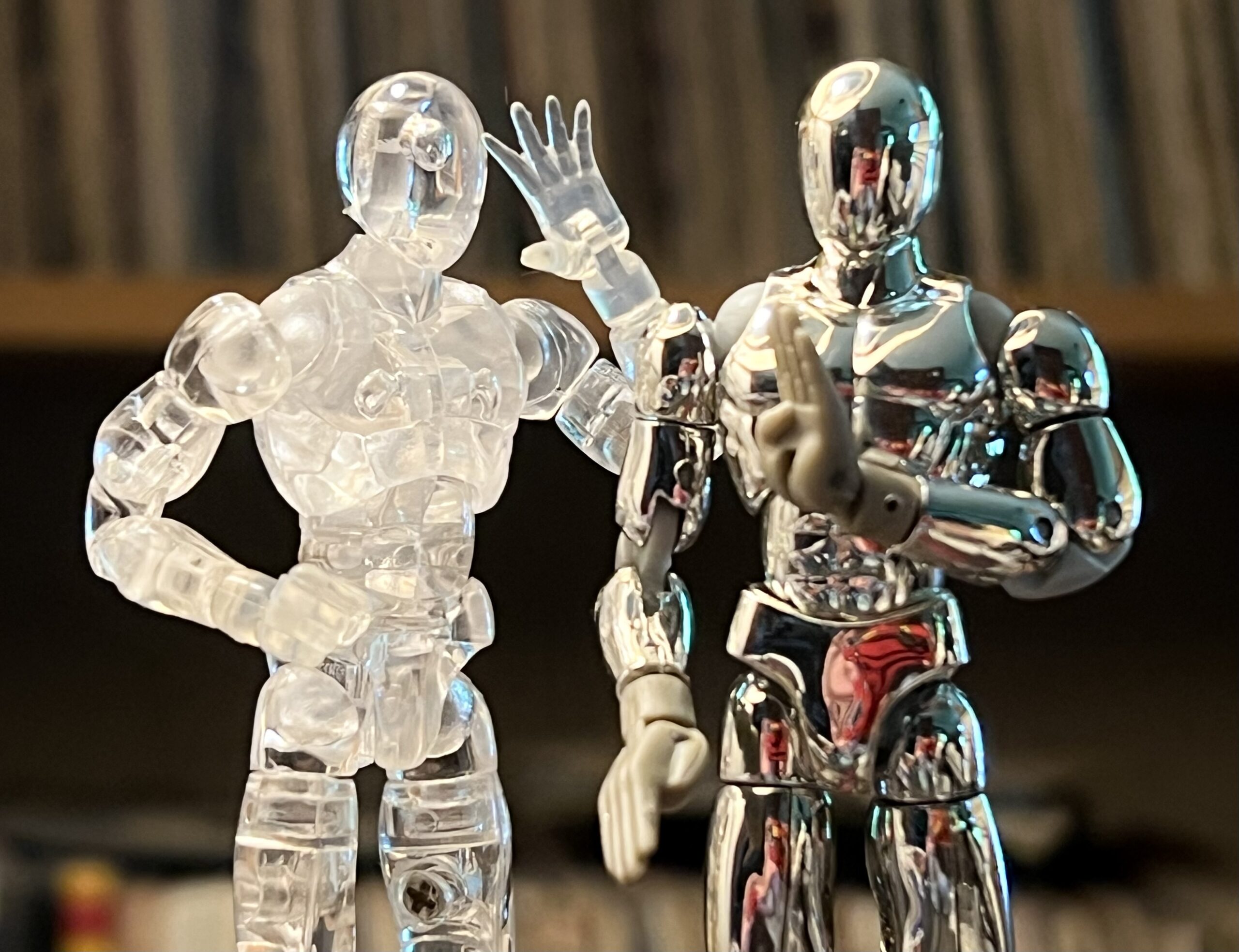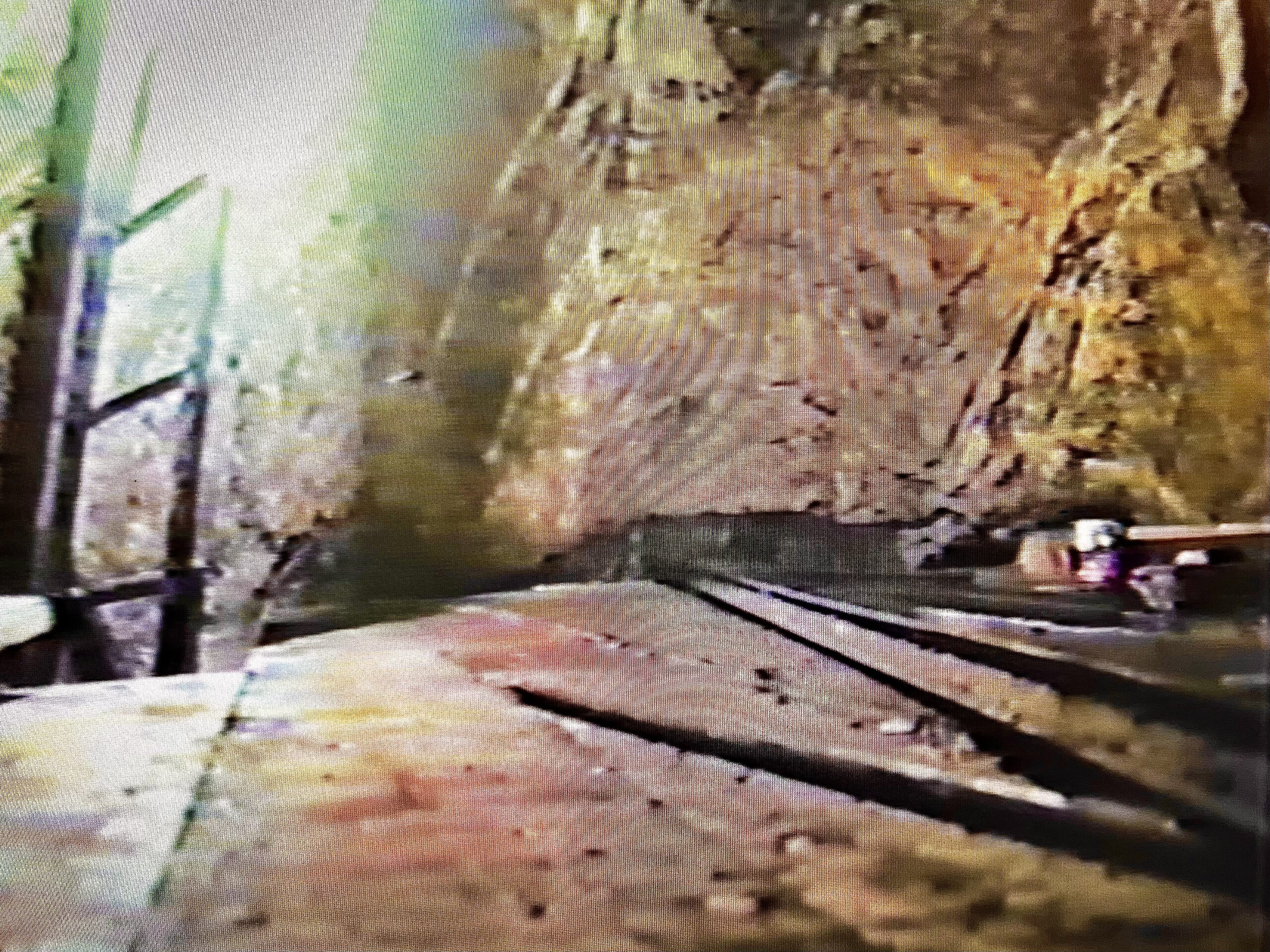A Correspondence with Roger White
Elaine Bleakney
Polo, 2008; oil on canvas, 22 x 27 in.
AL
I’m wondering if you would talk about some of the recurring objects in your recent work: the Brita water filter, the Kleenex box, the polo shirt. Why these objects?
RW
They’re in a blind spot. If you were asked to make an inventory of your possessions, you might simply forget you owned them. It’s no coincidence that they’re all bodily implements. There’s something fascinating about trying to represent the stratum of experience they evoke, the combination of familiarity and oblivion. It’s like trying to look at the back of your own head. Using them as the subjects for paintings puts the emphasis on how they’re painted, because there’s so little else to go on.
Brita, 2008; oil on canvas, 15 x 18 in.
With the Brita filters, there’s also an analogy to the role of the artist, who takes things in the world and distills them into a more refined state. I’m ambivalent about that.
The East, 2008; oil on canvas, 14 x 9 in.
AL
George Oppen has a line about his work in relation to clarity—”Not to reduce the thing to nothing—”—which your still life paintings trigger in me. I’m curious, too, about the role of branding as it operates in/on these objects and your selection of them; they have all slipped from their brand names, as their titles point out.
RW
I hadn’t thought in those terms about the titles: that there’s a substitution of a brand for a generic description of the object. There’s an interesting relationship to the trajectory of names within art: “a Jackson Pollock painting” becoming “a Pollock,” as if the object actually does take the place of the maker, who is then parceled out into his or her works.
In deciding how much or how little to describe in the paintings, I often drop the logos—Kleenex, Brita, Lacoste— because they’re redundant, so fused are brand and thing. But hopefully their branded-ness endures, so they don’t end up seeming too humble, or “honest,” Van Gogh’s boots, and so on.
Brita, 2008; watercolor on paper, 11 x 7.75 inches
AL
Would you say more about your ambivalence about the idea of an artist as someone who filters, selects, makes something “refined”? Is this an idea worn out, made trite by our culture?
RW
I thought of those ideas—filtering, ambivalence—specifically in terms of the way I work, which is repetitive and simplifying but not necessarily aimed at purifying or distilling. I do a lot of versions of the same thing, over and over, in drawings and watercolors and oils, until it approximates what I want. So the paintings are more refined in some senses, but by the end they’ve also shed a lot of other qualities—in many ways, they describe their objects less adequately at the end than at the beginning, and much less adequately than a simple snapshot would. Ultimately, the painting has accumulated a lot of strange quirks, many of them unconscious. And those minute adjustments are really the content of the painting, for me. They’re what I’ve added to the meaning of that object.
Untitled, 2009; watercolor on paper, 7 x 7.75 in.
AL
How you would talk about beauty in relation to your process? In beholding the thing do you already begin wanting to move into those “strange quirks” inherent in moving away (from drawing to watercolor to oil) from the object? The beauty in your work is immediate for me—as a viewer I’m wondering if it’s a goal, a destination, or something less articulate within the way you make art.
RW
I hope they’re beautiful. It’s hard to think about that head-on. There’s an unavoidable conflict between the way the subject of the painting can be beautiful and the way the painting itself can. They’re completely divergent.
It’s slightly easier to talk about preference, taste, desire, which are unavoidable issues in the paintings. With the shirts, I thought about the infinite variety of men’s striped polo shirts in the world, how small those variations are, how impossibly overdetermined my preference of one over another is by the complex mechanisms of consumer culture—and still, when I’m walking down the street, I’m always hoping to catch a glimpse of someone wearing the ultimate polo, the polo to end all polos.
Untitled, 2008; watercolor on paper, 9 x 12 in.
AL
Yes, I love how your polos redress (!) held notions of them as “prep,” signs of a certain class. By revisiting them I feel you wrest them away from a reified state assumptions about them put us in, turning them into canvas for play. Stripe, color, shirt-shadows, attention to fabric-as-field, do you feel close to Milton Avery in this? You’ve written about the “easy to miss” significance of his work…
RW
Avery’s work is easy to love, but he often gets relegated to the status of a transitional figure: Abstract Expressionism’s weird uncle. He didn’t want to iron the embarrassing, folksy, regional touches out of his work, the chickens and sunbathers and sailboats, so it seems like he didn’t quite make the leap into “pure” nonobjective painting, as his younger peers did. But I imagine that, for Avery, art was about playing at the outer limits of those pictorial conventions: seeing how far you could take a seascape without losing the connection between the image and its referent. That’s an entirely different idea about painting, not just a stage in the modern project. I’m similarly committed to thinking about painting in terms of pictures, even if sometimes the works are apparently abstract—it seems like a more promising way to proceed.
Clothes on the Floor, 2008; watercolor on paper, 6 x 11 in.
AL
What role does watercolor play in your process?
RW
I started making watercolors as a way to plan out oil paintings, and it quickly became an end in itself. There are some things I do in watercolor only, and others that originate in paintings and stay there. I don’t think of them as less or more finished or important than the larger paintings.
AL
Do you feel far afield from what’s happening in painting today? Does your writing about art help you contextualize what you’re doing within all that’s being done/has been done?
RW
It’s hard to find something that’s not happening in painting today: the field is huge and inclusive, there are plenty of great people doing anything and everything within it. I feel more detached from the discussion around painting than from the types of paintings being made. There’s a tendency when writing about painting to retreat into tentative, self-conscious formulations, like, “what would it mean to propose a concept of painting in which X is possible?” Operating at that level of remove is dizzying, and it now feels like a limitation, this endless deconstruction of the medium. There has to be something more pressing to talk about, in 2010, here on our troubled planet—even if it’s just the dull business of daily life.
So, writing: I hope, like a lot of people, to work my way out of a kind of static, depressed, internal analysis of painting, and find a way to talk about everything else painting does—without lapsing into an uncritical celebration of the medium.
AL
You must have hated my watercolor question, leading down the road to deconstruction! Though I wonder about what happens there for your work, still.
RW
Not at all. The watercolors are usually very small, and I often do five or six of the same image before it starts to go anywhere. At the same time, lots of unexpected things happen in them (the scale means that slight differences in mixing a color or handling the brush result in big variations), and that’s a useful feature. You can’t make two identical watercolors, no matter how hard you try. And once they’re done, they’re done; you can’t rework them, you have to start again. That’s the model for the paintings as well, which either work out or they don’t. I rarely go back into a painting and rework something, because they’re about being in a very focused place and doing something from start to finish with the same feeling.
Blue and White, 2009; watercolor on paper, 9.5 x 12 in.
AL
Do you often have an urge to rework/revise? Has error been useful, something agonizing, or something else?
RW
What is error, anyway, in the context of painting? I certainly believe in it, since I think some of things I make are successful and others aren’t. But that has little to do with fidelity, or being correct.
A while ago I made a bunch of paintings of dogs, in the manner of a fictitious pet portraitist, and I ended up thinking a lot about this issue. It’s very clear what success means when applied to a pet portrait. The animal in the painting is attractive, it resembles the subject, the fur is furry, the eyes sparkle. My attempts didn’t have those qualities. From that vantage point, they were unlovable. But within the broader field of painting qua contemporary art, a failed pet portrait can be a successful painting, and vice versa, and that’s the whole point. Those criteria are suspended. All criteria are suspended. That suspension is the purpose of continuing to paint. But at the same time, I’m often bored by art that can’t fail.
Chloe, 2008; watercolor on paper, 9.75 x 7.75 in.
AL
Detachment sounds like a necessary vantage for both your painting and your writing about painting. Cultivating the space to find a vital language (or a place where language fails, falters) vs. picking up a ratty discourse. Dwelling in possibility… (Do you like Dickinson?)
RW
I hardly know Dickinson at all. I should. But on the subject of faltering language (or thought), I do think about Wallace Stevens’s formula that “The poem must resist the intelligence / Almost successfully.” The “almost” is essential: not that the work of art is entirely beyond analysis, but that it’s just slightly beyond. A very modest form of mysticism. And in terms of art and language, it comes down to trying to exhaust the work of art in thought or in description and encountering a remainder—which isn’t “beyond language” in any ontological way, but represents the furthest point of analysis at the moment. Everything is explained eventually, but there are brief, wonderful periods of not knowing what’s going on.
AL
How do you feel about titling your paintings, as it relates to stepping out of making them, closer to their being viewed?
RW
I’m still deciding what these things should be called. It may take years… I think the titles should grate against the paintings slightly.
I’ve been working on a group of paintings that are all based on one sketch—a doodle, almost, that I made after waking up from a vivid dream. In the dream I was thumbing through a book of pictures of textiles, beautiful tapestries or weavings—a very postmodern dream, heavily mediated. When it came to titling these works, I felt like they should have people’s names, as if the titles indicated the makers of the nonexistent objects I was cribbing the paintings from. It’s easy on the internet to generate random names, and I selected a small group from a longer list and then tweaked them slightly. One was Walter Elevad, there was also Linda M. Sparks, Allan Hanway, Vera Lowering. Something about the rudimentary associations with the sounds of the words, below the level of reference or symbolism.
Walter Elevad, 2009; oil on canvas, 60 x 42 in.
AL
I was curious about Walter Elevad—I kept looking at this one wanting it to be Water Elevad, liking that it wasn’t that kind of precious title yet, still, zapping me with how many precious titles there are out there and the expectancy I have for them. I hope someone adopts “Walter Elevad” as a protagonist.
RW
It was originally Eleveld, and someone mistyped it for a show checklist. I decided this was an extension of the chance process that generated the name in the first place, so I went with it.
Mr. and Mrs., 2009; oil on canvas, 24 x 36 in.
AL
What are you reading right now? Anything in particular informing your work?
RW
Georges Perec’s writing was an influence. It worked on so many levels, from formal game playing, to sociological analysis to deep, wrenching stuff about pain and memory. He was able to keep everything in motion at once, and the humor of the work was in a necessary relationship to its broader goals. I had an edition of Things and A Man Asleep in one volume: an account of a young Parisian couple told through their relationship to material culture, and a description of drifting in and out of consciousness during insomnia. I admire the way he could look through both ends of the telescope.
AL
How do you think about the colors you use?
RW
Usually, it’s about getting the maximum effect from the simplest means. Doing the watercolors made me think a lot about transparency, which is a lot harder to control in oil painting. Sometimes the color is keyed to something particular in the subject of the paintings, at other times it comes out of something observed in the process. Each painting works differently—unfortunately. It would save a lot of time, otherwise.
Small Baja, 2009; watercolor on paper, 3.75 x 5.75 in.
*
Roger White has exhibited his work in New York, Los Angeles, and Marfa, Texas. He is represented by the Rachel Uffner Gallery. Along with Dushko Petrovich, he founded the art journal Paper Monument in 2007.

